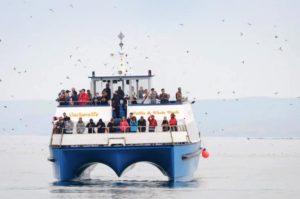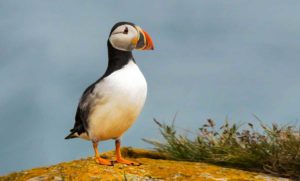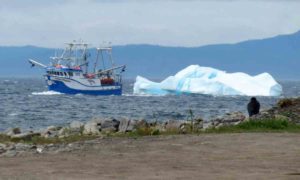Around the World
A Tale of Two Families – Bay Bulls’ Unique Tourism
Jul 2022 | By Pat Brennan
Ottawa’s Department of Transport thought it was some kind of April Fool’s Day joke.

The O’Briens and the Gatheralls were asking for a mutual licence to operate a 100-passenger tour boat to watch whales, Puffins, and huge icebergs gather along the southeast shore of Newfoundland. For more than 35 years, the two fishing families from Bay Bulls, Newfoundland had been fierce competitors in attracting tourists from around the world to their small town to head out to sea on a family fishing boat to watch Humpback Whales and colourful Puffins go fishing and icebergs go drifting by.
Although they were fierce competitors on the high seas, on shore the O’Brien brothers, Joe and Loyola and the Gatheral brothers, Michael and Al, have been good friends since grade school. The Corona virus has ended their annual competition out on the water and forced the two families together to keep whale watching alive on Newfoundland’s southeast coast. There simply weren’t enough tourists arriving in Bay Bulls last summer to support two separate tour-boat operations. And it’ll be the same next year. Around May 1 thousands of Humpback Whales arrive in Newfoundland’s waters to enjoy fish dinners with a side of krill and play with each other before they head south again in September to have their babies in warmer water.
The Southeast coast of Newfoundland off Bay Bulls is one of the most populous gathering spots on Canada’s east coast for Humpbacks, plus a half dozen other breeds of whales. And May 1 is also the normal return date for cute, colourful Puffins, auks that spend their winters out on the storm-tossed North Atlantic east of Newfoundland. They build their nests – only males do that – on craggy islands and sheer cliffs close to Newfoundland’s shores to avoid foxes and other land predators.

Getting aboard a tour boat is the best way to get up close to the Humpbacks and Puffins, and of course the huge icebergs that drift by until the middle of June. Last summer the O’Brien brothers operated their 52-foot-long, double-decker tour boat -The Atlantic Puffin – for a week, and for the following week Michael and Loyola took the helm of O’Brien’s 100-passenger boat.
Together the two families kept 60 young people employed all summer. The two Gatherall brothers and the two O’Brien brothers, plus their fathers and grandfathers before them, were Cod fishermen for years before creating their tour companies. The Cod moratorium imposed by the federal government in July 1992 shut that industry down, and the brothers had struggled through lean fishing years until opening their separate tour companies in 1986. Their passengers come from all over the world, but most are from Southern Ontario and Eastern Quebec – many on organized bus tours.
The brothers take their passengers out to an island in the Witless Bay Ecological Reserve that is home to 4.6 million seabirds – Puffins, Common Murres, Petrols, Razor Billed Hawks, Thick-billed Murres. “There’s a lot of noise and quite a smell. It gets louder as the tour boats approach. The birds aren’t disturbed, they’re just excited about visitors,” said O’Brien. He said some seabirds dive 600 feet underwater to catch a fish.
O’Brien says the whales also know when a tour boat has left the dock in Bay Bulls. “They have been coming up here as individuals for many years and they get to know us like we get to know them. We take photos of the flukes on their tails to identify each whale. We share the photos with whale watchers from around the world, and we’ll hear from some guy in New Zealand who said he saw that whale in New Zealand waters last year.” O’Brien said he doesn’t see the two families operating separate tour boats for the foreseeable future. “Even if the vaccinations get us back to a more mobile society, I think it would take a lot more time to get back to the volume of tourism we used to see here.”

If you do get to Bay Bulls – about 40 kilometres south of St. John’s – this summer, don’t be too concerned if you see coffee mugs in a restaurant with a Swastika emblazoned on the side. Late in World War II Bay Bulls had an unusual visitor. A German submarine surfaced 600 miles off Newfoundland beside an Atlantic convoy and offered to surrender. The Canadian Corvette crew that accepted the surrender said their vessel couldn’t leave the convoy, so they put some Canadian officers onboard to guide the sub into St. John’s. But as the submarine approached St. John’s the crew was told the harbour was jammed full of ships with no room to accommodate the sub and it would have to go south to Bay Bulls. The sub arrived in Bay Bulls at night and when the locals awoke the next morning there was some panic to find a hostile submarine floating in their harbour. “That German submarine was docked right beside my dock,” said Michael Gatherall, “and everybody in the village climbed inside to have a look and pick up a souvenir. “The coffee cups were very popular.”

